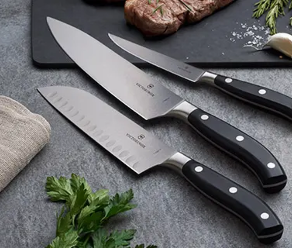Menu
History
Anatomy & Features
Guides
Balisong "Butterfly" Knife
Published: November 29th, 2024
Anatomy of a Balisong
Understanding the mechanics of a butterfly knife requires familiarity with its key parts. These components make up the knife’s distinctive structure and enable its quick, flipping action.
Blade: The central steel component, typically sharpened on one edge. The blade's sharp side is used for cutting, while the unsharpened edge, known as the swedge, often impacts the user’s hand during flipping but does not cut. Some models may sharpen the swedge for added utility.
Safe Handle: This handle closes over the unsharpened edge of the blade (swedge) and is generally the handle without the latch. It allows the user to safely manipulate the knife without risking cutting themselves.
Bite Handle: This handle closes over the blade’s sharp edge and will cut the user if they hold it while closing the knife. The bite handle typically carries the latch, distinguishing it from the safe handle.
Latch: The latch is the standard locking mechanism, securing the knife in either the open or closed position. Types of latches include:
Batangas Latch: Attached to the bite handle.
Manila Latch: Attached to the safe handle.
Spring Latch: Utilizes a spring to automatically open when the handles are squeezed.
Magnetic Latch: Occasionally used instead of a physical latch to hold the knife securely.
Latch Gate: A block within the handle channels that prevents the latch from colliding with the blade, thus avoiding damage or impact.
Tang: The base of the blade where the handles connect through pivot pins. This section of the blade is crucial for stability and secure attachment.
Tang Pin(s): Pins located on the tang that serve dual purposes: they prevent the blade from contacting the inside of the handles when closed (preserving sharpness) and, in some cases, keep the handles from striking each other during flipping. Some butterfly knives may use an additional tang pin to stabilize the blade further.
Zen Pins: These screws are mounted within the handles and meet the tang’s kicker to prevent the blade from moving excessively when fully open or closed. Zen pins offer an alternative to tang pins and give the knife a cleaner look by keeping pins out of view on the blade.
Pivot Joint: The pivotal connection that enables the blade and handles to rotate. High-quality balisongs often incorporate bushings or bearings at the pivot joints for smoother, more fluid action.
Choil: The unsharpened area of the blade near the tang, making it easier to sharpen the blade by providing a safe gripping point and reducing wear on the blade edge near the base.
Kicker (or Kick): A small area on the blade that prevents the sharp edge from contacting the handles when closed, preserving blade sharpness. In some designs, this is complemented by a tang pin positioned above the pivots for added stability.
Swedge: The unsharpened spine of the blade. On some butterfly knives, this area remains blunt to protect the user during flipping, while others sharpen it for additional functionality.
Handle Construction: Channel, Sandwich, or Chanwich
Balisongs typically feature two main handle construction styles, each with distinct benefits, and a third, hybrid construction that combines elements of both.
Channel Construction: In this design, each handle is crafted from a single piece with a channel to house the blade. Channel construction is valued for its durability and alignment, as it has fewer components that can loosen over time. This style is often preferred for traditional and rugged balisongs due to its simple, sturdy structure.
Sandwich Construction: Sandwich handles consist of layered materials with spacers, creating a slot for the blade. This design is popular among enthusiasts for its customizability and easy maintenance. Sandwich handles make it easier to access the internal components, allowing for modular adjustments and repairs, particularly beneficial in modern balisongs where customization is a priority.
Chanwich Construction: A hybrid of channel and sandwich styles, chanwich construction features two halves of a channel handle screwed together. Though rare, this design combines the best aspects of both constructions, maintaining the solid handle shape typical of channel construction while allowing adjustable handle tightness, easier maintenance, and access for cleaning. This innovative approach is ideal for users seeking the durability of channel handles with the flexibility of sandwich construction.
The Evolution of the Balisong
Over the years, balisong materials have transitioned from traditional resources to high-tech composites, enhancing the knife’s durability, aesthetics, and performance. Early balisong blades were typically crafted from simple carbon steel, which provided excellent sharpness but required regular maintenance to prevent rust. In modern designs, high-carbon stainless steels such as S30V and M390 are common, offering superior edge retention and corrosion resistance, making the knife more suitable for demanding use.
Traditional handles were made from local materials like water buffalo horn or hardwood, valued for their strength and classic appeal. Today’s balisongs feature advanced materials in handle construction, such as titanium and aluminum for lightweight durability, and composites like G-10 and carbon fiber for additional strength and aesthetic appeal. This evolution has enabled balisongs to meet the diverse needs of enthusiasts and professionals alike.
Modern butterfly knives also frequently incorporate ball bearings, bushings, or phosphor bronze washers around the pivot pins, reducing friction and promoting smooth flipping. These additions significantly extend the knife’s lifespan and are particularly beneficial for high-performance models where fluid action is essential.
The balisong’s flipping action is one of its most defining features, requiring finely tuned engineering to ensure seamless operation. Components such as pivot joints, handle balance, and tang pins all contribute to the knife’s performance.
A well-engineered balisong offers smooth, low-friction pivots, providing easy handle rotation. Balanced weight distribution is also essential for control, allowing users to perform complex flips and maneuvers safely and fluidly. Adjustable pivot screws, removable spacers, and high-quality washers or bushings help advanced models achieve this smoothness, making them popular among enthusiasts who value precision handling.
Balisong with phosphor bronze washers (left)
Balisong with bearings (right)
Customization has become central to the modern balisong experience, with manufacturers producing models that allow modular adjustments. Enthusiasts may experiment with different setups to suit their style, often swapping out components such as spacers, latch types, or pivot systems.
Certain balisongs crafted by renowned makers have reached collectible status, with limited-edition models highly sought after. Companies like Benchmade and Lovins Customs produce premium butterfly knives that offer smooth action, durability, and unique design, catering to both performance enthusiasts and collectors.
The balisong knife stands as a blend of innovation, tradition, and skill, captivating knife enthusiasts around the world. Its intricate construction, specialized parts, and performance capabilities have transformed it from a regional utility tool into an international icon. Each component, from the blade and handles to the latch and pivot system, reflects precise engineering designed for durability, control, and function.
Whether valued as a practical tool, a collectible, or an object of skilled performance, the balisong continues to represent the intersection of form and function. Its history and unique construction have solidified its place in knife culture, marking it as one of the most intriguing and respected designs. The balisong’s evolution, from a Filipino folding knife to a globally appreciated piece of engineering, highlights its unmatched versatility and lasting appeal.
Written by Drew Clifton
What to Buy
The Kershaw Lucha is a well-balanced balisong with a rugged BlackWash finish, offering a well-worn aesthetic. Featuring a 4.6" Sandvik 14C28N stainless steel drop-point blade with black-oxide coating, the Lucha operates on dual KVT ball bearings for smooth flipping action. Its blue stainless steel handles, rounded with bevels, provide comfort and control during use. With a closed length of 5.8" and a weight of 5.9 oz, this USA-made knife combines strength and sleek design, ideal for enthusiasts and collectors alike.
The Benchmade Necron Balisong is a premium butterfly knife that blends precision craftsmanship with modern design. Featuring a 4.59-inch CPM S30V scimitar blade with a stonewash finish, it offers superior edge retention, corrosion resistance, and rugged durability. Its Ruby Red G-10 handles ensure a lightweight, ergonomic grip and enhanced durability. The knife’s latchless design and adjustable tungsten weights provide smooth flipping action and optimal balance, making it ideal for enthusiasts. With a closed length of 5.08 inches and a weight of 4.21 ounces, the Necron Balisong is both compact and easy to carry. Proudly made in the USA, this balisong is perfect for collectors and EDC users alike.
The Lovins Customs Strix is a premium American-made butterfly knife crafted by champion balisong flipper Corbin Lovins. Featuring a 4.5" CPM S35VN stainless steel tanto blade with a sleek satin finish, this knife combines precision and durability. Its pink anodized titanium handles, equipped with zen pins and weight-reducing cutouts, offer an optimal balance for smooth flipping. At 5.5" closed and weighing 4.4oz, the Strix is both functional and eye-catching. Each knife includes a certificate of authenticity and a high-quality black zippered nylon pouch for safe storage. Proudly made in the USA.
Expert Reviewed
T.C. Barnette
T.C. Barnette is a dynamic media personality and the esteemed spokesperson for SMKW (Smoky Mountain Knife Works), where his passion for knives intersects with his captivating on-screen presence. With a magnetic charisma and deep expertise in cutlery, T.C. has become a beloved figure in the knife community.






































